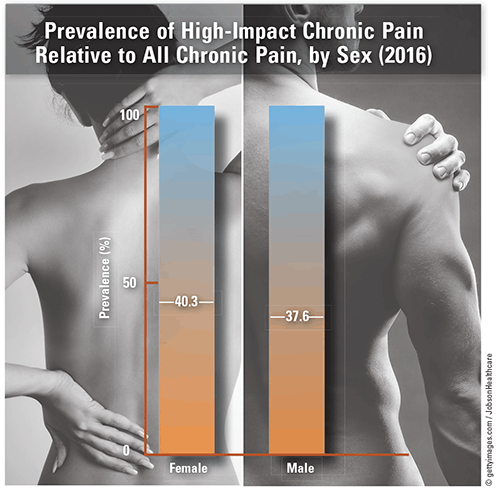US Pharm.2020;45(3):HS-16.
In a study assessing Medical Expenditure Panel Survey data on noncancer pain and pain-related treatment by physicians over an 18-year period, the prevalence of pain increased by 25% from 1997, and by 2013 to 2014, 68 million adults had pain that interfered with their work. The most relief that chronic-pain medication or medical procedures provided was 25% to 30%. According to a recent CDC report, the suicide rate among persons with chronic pain increased from 7.4% in 2003 to 10.2% in 2014.

High-Impact Chronic Pain (HIP): This relatively new pain classification is characterized by worse pain, increased mental-health problems and cognitive impairments, and at least one major activity limitation for at least 3 months. HIP has been diagnosed in 39% (25.3 million) of the 65.3 million adult chronic-pain sufferers. According to 2011 National Health Interview Survey (NHIS) data, there is a fourfold increased risk of disability among chronic-pain sufferers. About 83% of HIP patients were unable to work for a living, and 33% had difficulty with self-care activities such as washing themselves and getting dressed. Compared with patients without pain, those with HIP were more likely to be female.
Management of Chronic Pain: Chronic pain affects 5% of children and 38% of adolescents. Pain management in these patients is imperative, as it may have an impact on response to pain therapy during adulthood. Forty percent of the more than 14 million cancer survivors experience treatment-related chronic pain, and chronic pain is also encountered in hospice and palliative-care settings. Chronic pain and HIP occur in 30% to 40% of adolescents and adults with sickle cell disease, and pain incidence and severity increase with age. A 2011 Institute of Medicine report highlighted the shortage of pain-management specialists, citing that for every physician who is board-certified in pain care, there are more than 28,500 Americans with chronic pain. Other than federal prescribers, who are required to undergo training, fewer than 20% of the more than one million healthcare providers who are licensed to prescribe controlled substances have been trained in the safe and effective prescribing of pain medications and therapies.
Demographics: NHIS data for 2016 showed that, of chronic-pain sufferers aged 65 years and younger, 35.4%, 59.3%, and 36.5% were veterans, had Medicaid coverage, and were uninsured, respectively, and 40.8% lived in a rural area. Among HIP sufferers, 23.1% were employed; of unemployed HIP sufferers, 47.5% had worked previously. The highest prevalence of HIP occurred in those aged 85 years and older (47%), followed closely by those aged 45 to 64 years.
To comment on this article, contact rdavidson@uspharmacist.com.






